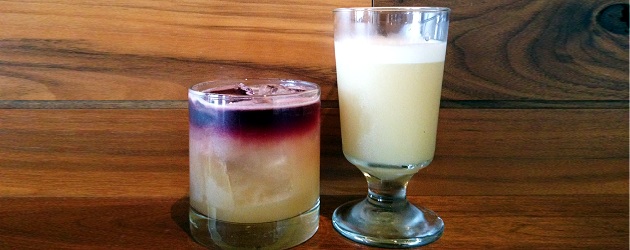.
By Dappered Drinks Correspondent and Official Bartender Michael Bowers
If you’ve only had whiskey sours made with sour mix, you’ve never really had a whiskey sour. A whiskey sour made with sour mix is like a grilled cheese made with Velveeta: it’s not so much a substitute for the real thing as a willful act of bad taste. And, at risk of straining the comparison, good whiskey sours, like good grilled cheeses, are insanely easy to make, hinge on the quality of your ingredients, and are perfect starting points for embellishment. Below are some recipes, one for a classic Whiskey Sour and one for my favorite embellishment of the original, the New York Sour.
The New York Sour simply adds a float of red wine to the top of the drink. It sounds odd at first, but once you’ve tried it you might cast aside the standard sour entirely. Don’t mix the layer of red wine into the drink—drink through it. The contrast between the aroma of the wine on top and the flavor of the drink below is what makes the New York Sour so special.
Though it’s not necessary for flavor, you should consider using the optional egg white in the first recipe. Egg white adds a fantastic silky texture to a whiskey sour (or any other cocktail for that matter). Use the freshest eggs possible to avoid any eggy smell or taste.
And with both drinks, two general rules of mixing drinks apply: use freshly squeezed juice, and don’t mix with booze you wouldn’t drink on it’s own.
Whiskey Sour
- 1.5 oz Rye or Bourbon whiskey
- .75 oz Fresh lemon juice
- .5 oz 2:1 simple syrup*
- 1 egg white (optional)
Combine all and shake. Shake with extra vigor if using the egg white. Strain into a chilled cocktail glass or coupe, or serve over ice if you are so inclined. Garnish is unnecessary.
New York Sour
- 1.5 oz Rye Whiskey (100 proof is preferable)
- .75 oz Fresh lemon juice
- .5 oz 2:1 simple syrup*
- .75 oz Dry red wine
Shake rye, lemon juice and simple syrup and strain into a double old fashioned glass filled with ice. Gently pour the wine over the back of a spoon held just above the drink so that it floats on top.
*Combine two parts sugar and one part water in a pot over medium heat. Whisk until sugar is dissolved and remove from heat. Do not let the syrup come to a boil. Add one large pinch kosher salt per cup of sugar used and whisk again to dissolve. Let cool. Store in a jar in the fridge and it will last nearly forever.
About our Bartender – Michael Bowers is the Head Bartender at the Modern Hotel and Bar in Boise, Idaho. His patrons know him for the uncanny precision with which he tends his bar. Michael’s cocktails have been noted by, among others, Food and Wine, Sunset Magazine, GQ, and the New York Times. See more in The Drink archive.

